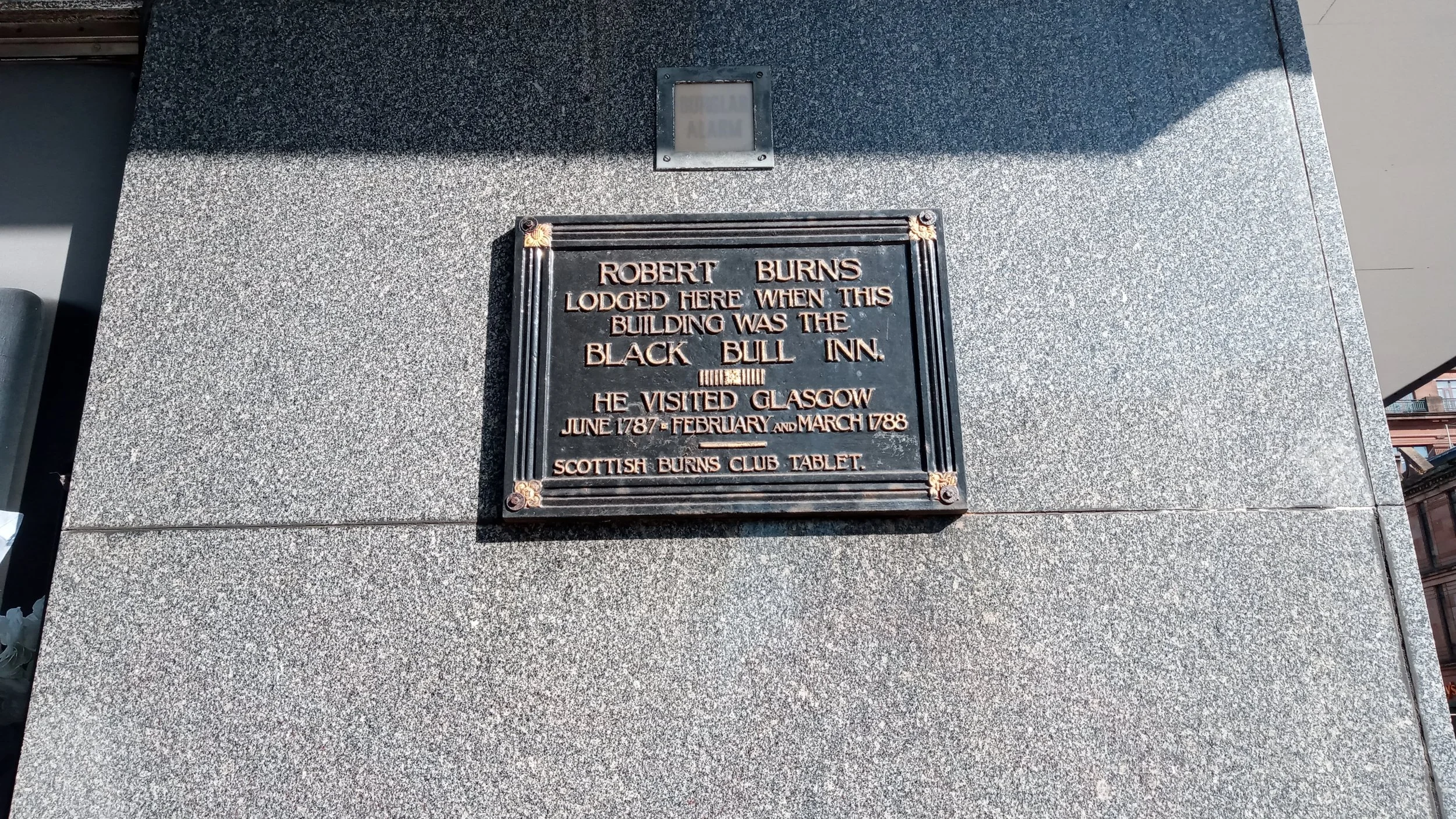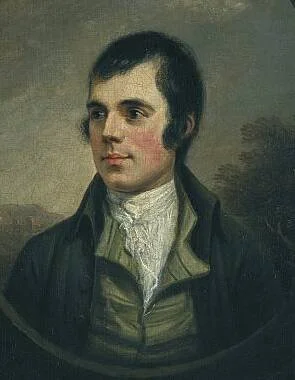The Black Bull Inn and Hotel on Argyle Street
Lithograph by William Ferguson c. 1840
The Marks and Spencer store on Argyle Street is built on the site of the Black Bull Inn and Hotel, once one of the most fashionable venues in Glasgow. One of the most famous visitors to the Black Bull was Scotland’s national poet, Robert Burns, who was resident there on at least two occasions, in 1787 and again in 1788. Those visits are commemorated by a plaque on the Virginia Street side of the building.
The plaque on Virginia Street
The Black Bull enjoyed a prominent position during the second half of the 18th and early 19th century, on one of the most important streets in Glasgow at the time. Built for the Highland Society around 1758, the hotel boasted a large hall, a dining room, 29 parlours or bedrooms, a large kitchen and a servant’s hall. To avoid disturbing guests trying to sleep, the inn was a suitable distance away from the bedrooms.
Argyle Street, 1830
Well equipped to deal with functions, large and small, in its heyday, the Black Bull played host to hunt balls and other society events. Some of the smaller function rooms provided space for political groups to meet. The Fox Club, supportive of the Whig Party, held meetings there. Their great rival was the Pitt Club, more sympathetic to the Tory Party. The Literary and Commercial Society of Glasgow met there, whose members included Adam Smith, David Hume, and the great orator Edmund Burke. The inn was also frequently used for public auctions and bankruptcy hearings.
Within the hotel building, there was an office to book a place on the coach to Edinburgh. That coach, memorably described as ‘a fly on steel springs’ left from the hotel, three times a week, on Mondays, Wednesday and Fridays, and returned from the capital on Tuesdays, Thursday and Saturdays. The stables could accommodate 40 horses and the hayloft held 5000 stones or 30 tonnes of hay.
The courtyard was always a hive of activity, with coaches coming and going, all through the day, and because of its arena-like qualities, was a favoured place amongst schoolboys for settling ‘affairs of honour’, partly because there was a water pump or well, convenient for washing bloody noses after the dispute was settled.
Robert Burns by Alexander Naysmyth, 1821
When Robert Burns visited Glasgow in 1787 and 1788, he stayed at the Black Bull. His visit to Glasgow was primarily for professional reasons but it was also an opportunity to continue his friendship with Agnes (‘Nancy’) McLehose, a woman with whom he had engaged in a passionate correspondence. She was a married woman who lived on or near St Andrew’s Square. Her husband had deserted her and their three children a few years earlier and left for Jamaica.
Burns was also married, so physical consummation of the affair would have been a scandal, but in their letters to each other, the depth of mutual feeling is clear. Burns used the penname Sylvander, while she replied as Clarinda. Here’s a couple of examples -
Sylvander to Clarinda
When dear Clarinda, matchless fair,
First struck Sylvander's raptur'd view,
He gaz'd, he listened to despair,
Alas! 'twas all he dared to do.
Love, from Clarinda's heavenly eyes,
Transfixed his bosom thro' and thro';
But still in Friendships' guarded guise,
For more the demon fear'd to do.
Clarinda to Sylvander
The morning sun shines glorious and bright,
And fills the heart with wonder and delight !
He dazzles, in meridian splendour seen,
Without a blackening cloud to intervene.
So, at a distance view'd, your genius bright,
Your wit, your flowing numbers can delight,
But ah! when error's dark'ning clouds arise,
When passion thunders, folly's lightning flies
More safe we gaze, but admiration dies:
And as the tempting brightness snares the moth,
Sure ruin marks too near approach to both.
Good night; for Clarinda's "heavenly eyes" need the earthly aid of sleep. Adieu.
CLARINDA.
P. S. I entreat you not to mention our correspondence to one on earth. Though I've conscious innocence, my situation is a delicate one.
Despite their obvious passion for each other, Agnes resisted, and she eventually left for Jamaica, to attempt a reconciliation with her husband, but the affair inspired Burns to write perhaps his most famous love song ‘Ae Fond Kiss’, essentially a goodbye to his beloved Nancy, which begins -
Ae fond kiss, and then we sever
Ae fareweel, and then forever
Deep in heart-wrung tears I'll pledge thee
Warring sighs and groans I'll wage thee
Walter Scott later said that their correspondence ‘contains the essence of a thousand love affairs’.
Sometime in the early twentieth century, following the formation of the Scottish Burns Club in Glasgow, a plaque or tablet commemorating the poet’s visit was placed on the wall of the hotel.
The plaque on Virginia Street
The arrival of the railways in Glasgow, almost certainly, led to the demise of the Black Bull Inn and Hotel. The new Edinburgh to Glasgow railway line, terminated at George Square, at what was known originally as the Dundas Street Station, now Queen Street station. The Queen’s Hotel (now the Millennium Hotel) next to the station became one of the most popular hotels for travellers between the two cities.
The Scotsman, 21 March 1846
George Clark took over the lease of the Black Bull in 1842 and enjoyed some initial success. Coaches were available at the train station, to bring travellers to his establishment on Argyle Street but the city was changing. In 1846, improvements were made to the fabric of the hotel, but, in 1849, Clark did not take the opportunity to renew the lease. George Square was becoming a more fashionable part of town, Argyle Street was becoming more commercial. By May of 1849, Clark had moved on to another, the London hotel on Maxwell Street, and the Black Bull had ceased trading.
Within a few weeks, the ground floor of the hotel had been converted to a warehouse, or department store, by a company called Mann and Simpson, formerly based at 170 Trongate. This move was probably facilitated by a new partner, Steven Byars, previously associated with a rival company, Stuart & MacDonald, based further along Argyle Street.
Glasgow Chronicle, 29th August 1849
Mann, Simpson & Byars opened from their new premises at 12 Argyle Street, in late 1849. The building was redeveloped and extended a number of times over the years, there was an entrance on Virginia Street, and later another spectacular entrance on Glassford Street. Simpson seems to have left the left the partnership sometime in the 1860s, and from that point onwards, the store was known simply as Mann & Byars.
Mann and Byars, 12 Argyle Street circa 1870
The company finally folded around 1938, the annual report that year cited difficulties caused by ‘the international situation’. The stock and premises at Argyle Street was acquired by rival company, Stewart & McDonald, who were also based on Argyle Street.
Trade still continued at 12 Argyle Street for another 20 years – first by a company called Boness Ltd, a drapery store and latterly the store was known as Hughes Ltd.
Hughes Store in the 1950s
The building was finally demolished in 1958. The plaque commemorating Burns’ visit was saved and remounted on the side of the new Marks and Spencer building, when it opened in 1966.
Demolition in the early 1960s, clearing the site for the new M&S store









